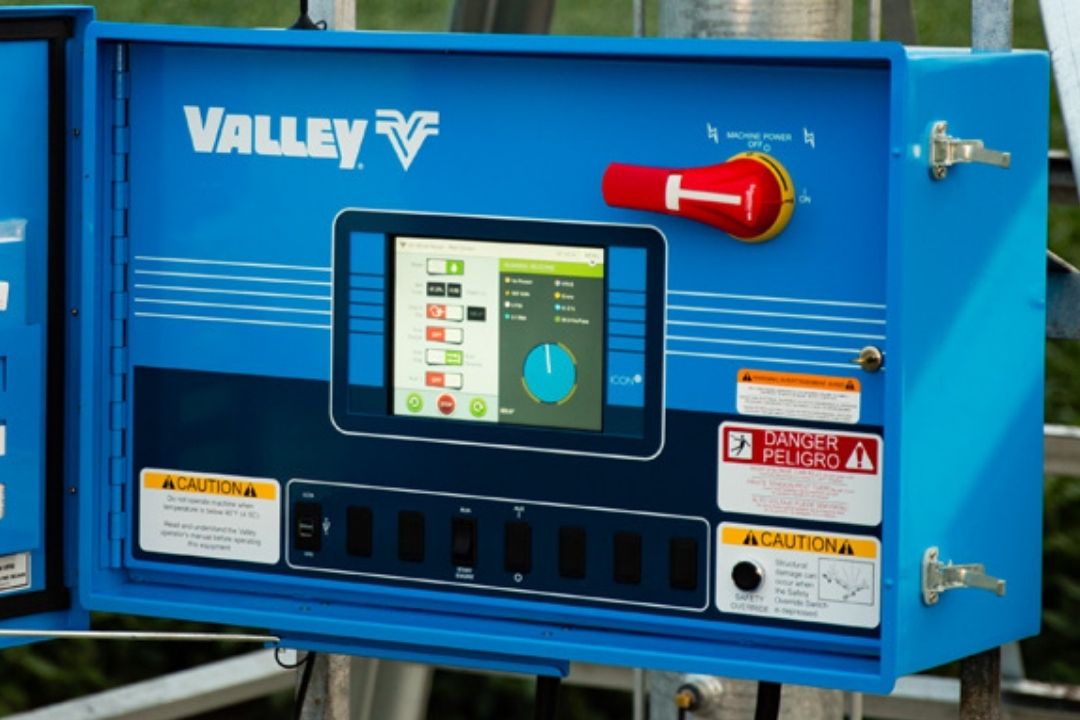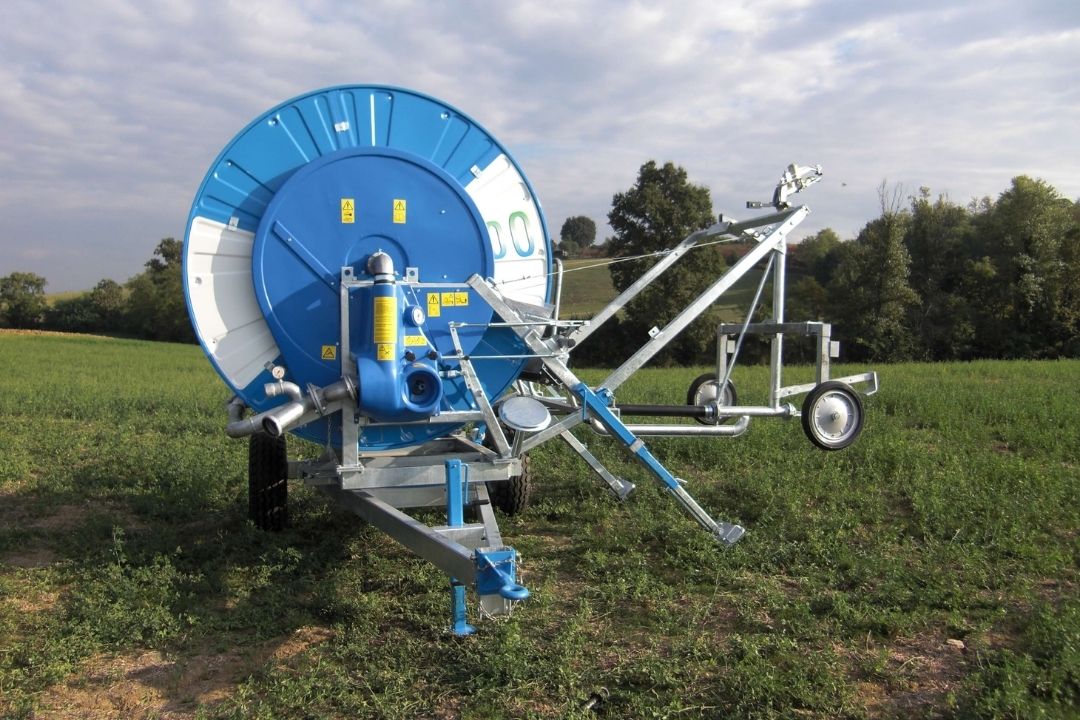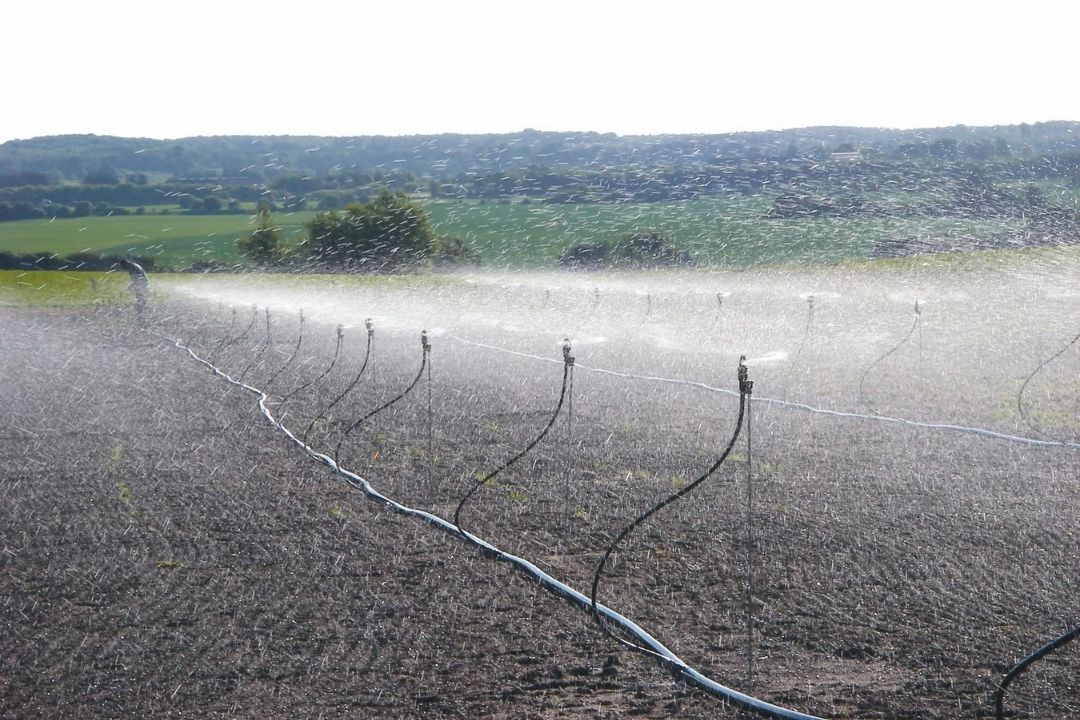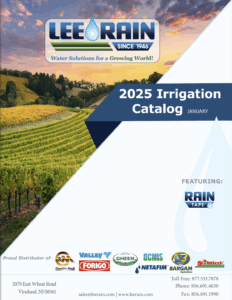
Why November Through January Is the Best Time for a Pivot Inspection
Now that harvest is behind you, it’s the perfect time to schedule a Pivot Preventative Maintenance Inspection and make sure your system is ready to roll next year.
Just like any piece of equipment that runs hard through the season, your pivot needs regular attention. Over time, wear and tear can lead to small issues: loose connections, aging gaskets, or worn gearboxes; that quietly build into costly breakdowns. And when those breakdowns happen in the middle of a dry summer, they cost more than parts and labor. They cost you time, yield, and peace of mind.
That’s where preventative maintenance pays off. A Pivot Preventative Inspection is designed to catch problems early and keep your system performing like it should, season after season. By going through a detailed checklist that covers electrical, mechanical, and structural components, technicians make sure your pivot—no matter the brand—is field-ready when spring planting arrives.
Why Now Is the Time to Schedule
It’s smart to schedule your pivot inspection now to secure your spot before the winter rush begins. Here’s why:
- Avoid spring delays. When the season hits, service departments book up fast. Scheduling now ensures your pivot gets serviced first.
- Stay ahead of cold-weather risks. Freezing temps can cause damage if small leaks or electrical issues go unchecked. Winter inspections prevent bigger problems come spring.
- Plan repairs on your schedule. If pivot parts or upgrades are needed, there’s time to order and install without delaying your first irrigation run.
- Protect your investment. A little maintenance now extends the life of your pivot, reduces emergency costs, and ensures consistent performance for years to come.
How Lee Rain Can Help
Lee Rain’s certified technicians take the guesswork out of pivot maintenance. Our team performs full Pivot Preventative Program inspections that include a comprehensive evaluation of your machine’s key components: Control Panel, Tower Boxes, Gearboxes, U-Joints, Booster Pumps, etc. We’ll identify any issues and provide a detailed report so you know exactly what your system needs and when.
Whether you run a Valley pivot or another brand, we’ve seen firsthand how a simple inspection today can prevent major downtime tomorrow. It’s a small step that delivers big results in reliability, efficiency, and peace of mind.
Get Ahead for Next Season – and Save
Our Preventative Maintenance Promo runs from November 24 through January 31, offering 5% off select parts when you participate during that window. Appointments can be scheduled now to lock in your inspection time and ensure your pivot is ready to roll when the season starts.
Contact your Lee Rain representative today: 877-533-7878 to schedule your Pivot Preventative Inspection and keep your irrigation investment running strong for years to come

Don’t Let Your Soil Become a Graveyard for Next Year’s Crops
This fall, the scariest thing hiding in your fields isn’t Halloween decorations, it’s what’s happening below the surface of your soil. As autumn sets in, Lee Rain wants to remind growers that soil care doesn’t stop when the temperatures drop. Ignoring it now can come back to haunt your fields next spring.
In this article, we’ll uncover the hidden dangers of dry soil, why fall moisture management still matters, the creeping threat of soil compaction, and the tools you can use to protect your soil for the upcoming year.
The Hidden Dangers of Dry Soil
September mornings can be deceiving. Heavy dew may glisten across the fields, giving the illusion that soil is plenty moist. (Check out our September article, The Science Behind Dew, for more on why this happens.)
But here’s the reality: surface moisture from dew doesn’t replace consistent soil hydration. Dry or compacted soil can suffocate roots, limit nutrient uptake, and slow microbial activity, creating an unproductive environment.
 Spooky twist?
Spooky twist?
Think of neglected soil as a graveyard where nothing thrives.
Why Moisture Still Matters in Fall
Even as crops come off the field, your soil isn’t done working. Fall moisture supports:
- Cover crop establishment — giving seeds the moisture they need to sprout and
anchor. - Root development — helping perennial and overwintering plants stay strong.
- Erosion prevention — protecting topsoil and nutrients from blowing or washing away.
Efficiency is key. Whether you’re running pivots, drip systems, or hose reels, even short run times can make a big difference in keeping soil healthy heading into winter.
Understanding Soil Compaction
As harvest season ramps up, so does traffic from combines, trucks, and heavy equipment. That pressure compacts the soil, squeezing out pore spaces that roots, air, and water depend on. Without intervention, compaction becomes a lingering problem. Buried now, but certain to return at spring planting. Compaction reduces infiltration, slows drainage, and can even force roots to grow sideways instead of down, limiting access to nutrients.
How Tillage Can Help
Compaction may sound like a curse, but the right tillage practices can break the cycle. Tools like subsoilers and decompactors target deep layers of compacted soil, restoring porosity and encouraging 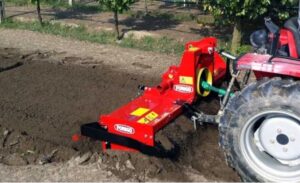 root penetration. Secondary tillage can further prepare soil structure, creating an environment where cover crops and spring crops can flourish.
root penetration. Secondary tillage can further prepare soil structure, creating an environment where cover crops and spring crops can flourish.
But caution is key: too much or poorly timed tillage can damage soil life. The right machinery, like Forigo’s line of precision tillage equipment
is designed to reduce compaction risks while preserving soil health.
Tools & Products to Defend Your Soil
The good news? You don’t have to face these hidden villains alone. With the right tools, you can protect your soil and set yourself up for a stronger spring:
- Soil Moisture Indicators — Take the guesswork out of irrigation. Indicators help you track actual soil hydration, ensuring you’re not fooled by surface dew.
- Drip Irrigation — Delivers precise moisture right where roots need it, supporting microbial activity and reducing the risk of creating “dead zones.”
- Forigo Reverse Tillers — From decompactors and subsoilers that break up hardpan layers to secondary tillage tools that restore porosity, Forigo equipment helps fight the “creeping threat” of compaction. Their machinery is designed to maintain soil structure, improve infiltration, and reduce long-term damage caused by heavy harvest traffic.
At Lee Rain, we help growers keep their soils alive and thriving with the tools to stop compaction and protect fall soil health.
Conclusion (Treat, Not Trick)
Healthy soil means fewer scary surprises next season. Don’t let your fields become a graveyard for next year’s crops.
Contact Lee Rain today to learn how our fall irrigation and tillage solutions can help you defend your soil and get a healthy start next spring.

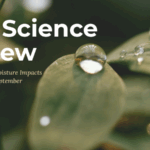
The Science Behind Dew
How Morning Moisture Impacts Your Crops in September
Early September mornings have a magical feel. The sky glows pale pink as the sun begins to rise, and a crisp breeze hints at the season ahead. Across the fields, a shimmer of water clings to the surface. It didn’t come from rain or your irrigation system — it’s dew.
 Why September Brings More Dew
Why September Brings More Dew
This month is the perfect setup for heavy morning dew: warm afternoons, longer nights, and clear skies after late-summer cold fronts. As nights cool, air loses its ability to hold water vapor. When crop leaves cool below the “dew point,” that moisture condenses into droplets.
September’s dew is often heavier than in midsummer because the nights are cooler and longer, giving more time for condensation to form.
The Benefits of Dew in Early Fall
 A Gentle Morning Boost: For shallow-rooted or stressed crops, that light moisture can ease early-day water stress.
A Gentle Morning Boost: For shallow-rooted or stressed crops, that light moisture can ease early-day water stress.
Temperature Buffer: Dew helps leaves adjust from cool nights to warm days without shock.
Weather Clues: Consistent heavy dew often means calm, stable weather — a good sign for harvest planning.
The Risks That Come With It
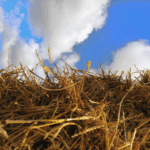 Fungal Growth: Leaf wetness from dew can last for hours, giving diseases like powdery mildew the conditions they need to spread.
Fungal Growth: Leaf wetness from dew can last for hours, giving diseases like powdery mildew the conditions they need to spread.
Harvest Delays: Crops like hay, small grains, or leafy greens can’t be stored wet, meaning you may have to wait for the sun to dry them.
Pest Activity: Damp mornings can bring out certain insects that thrive in moist conditions.
Making the Most of Dew Season
Dew doesn’t have to be a problem — in fact, with the right approach, it can actually work in your favor. Here are a few ways to turn those damp mornings into an advantage:
Time your irrigation wisely. If mornings are already wet, hold off until later in the day. This prevents leaves from staying damp for too long and helps reduce the risk of disease.
Walk your fields at sunrise. Dew makes leaf surfaces glisten, which also makes it easier to spot the first signs of fungal problems or insect activity. Morning scouting gives you a clearer picture of what’s happening in your crops.
Be patient with harvest. For hay, grains, and greens, cutting or storing while wet can hurt quality. Waiting until the dew burns off ensures a cleaner, safer harvest.
A September Takeaway
 Dew is one of nature’s quiet signals that the season is changing. This month, pay attention to how it affects your crops — for better or worse — and adapt your practices accordingly. As we move from the heat of summer toward the cool of fall, those sparkling droplets tell you the harvest season is just around the corner.
Dew is one of nature’s quiet signals that the season is changing. This month, pay attention to how it affects your crops — for better or worse — and adapt your practices accordingly. As we move from the heat of summer toward the cool of fall, those sparkling droplets tell you the harvest season is just around the corner.
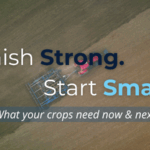
Finish Strong, Start Smart: What Your Crops Need Now and Next
August is a pivotal time in agriculture. The month begins with peak summer heat but gradually cools as fall approaches. It’s the perfect time to finish the season strong — and start planning for what’s next.
In this article, we’ll outline what your crops need most right now and share steps to help you transition smoothly into a productive fall season, whether you’re managing fields, greenhouses, or nurseries.
Part 1: What Plants Need in August
This is the final — and often most intense — month of summer heat, so it’s important not to ease up on irrigation just yet. Consistent and accurate watering will help your crops thrive through August and set them up for a strong finish.
![]() With temperatures still soaring, reducing plant stress is key — and that includes reducing your stress, too. Sticking to a reliable, automated watering routine can prevent problems later and keep both you and your crops in better shape for the transition into fall. Tools like the Valley ICON smart panels (ICON5, ICON10, or ICONX) give you remote access and control with built-in AgSense® integration, so your pivots stay on track even when you’re off-site.
With temperatures still soaring, reducing plant stress is key — and that includes reducing your stress, too. Sticking to a reliable, automated watering routine can prevent problems later and keep both you and your crops in better shape for the transition into fall. Tools like the Valley ICON smart panels (ICON5, ICON10, or ICONX) give you remote access and control with built-in AgSense® integration, so your pivots stay on track even when you’re off-site.
It’s also crucial to make sure your plants are receiving the nutrients they need. This starts with healthy, well-prepared soil, but sometimes late-season crops need a little extra help. Fertilizer injectors and filters can be your best tools here. Using options like the Mazzei, MixRite, or CDS E-Z Pumps injectors, paired with filters like the Lee Rain Turbo Vortex, Sand Media, or Plastic Screen Filters, ensures your system delivers nutrients cleanly and effectively, without the risk of clogging or uneven application.
And finally — stay on top of wear and tear. After a summer of intense and sometimes unpredictable weather, your system might be showing signs of strain. August is when clogs, leaks, and pressure issues tend to show up. Taking care of them now can prevent costly delays down the road.
Lee Rain offers seasonal maintenance checks to help ensure your system is running efficiently and ready for the next season. A quick inspection now can make a big difference come fall.
Part 2: Prep Now for a Productive Fall
As August winds down, it’s the perfect time to shift gears from summer survival to fall planning. A little preparation now can save you valuable time and energy when the season changes — especially if you tackle small upgrades and maintenance before the fall rush.
Check for Weak Points
After months of heavy use and heat, it’s important to inspect your system for wear — especially at the connections. Fall is a smart time to:
- Replace worn PVC or compression fittings
- Patch or swap out damaged layflat hose
- Inspect manual and electric valves for performance
You’ll find a full range of these parts in our catalog — from male adapters and tees to valves and clamps.
Consider Upgrades
If your operation needs a little more reach or adaptability heading into fall, this is the time to make it happen:
- OCMIS hose reels are a reliable solution for larger systems or expanding coverage to new zones.
- Portable, easy-to-deploy hose like Netafim’s FlexNet can help you set up temporary or seasonal layouts quickly.
Planning now means you’re not scrambling when demand picks up later.
Automate for Efficiency
Looking to reduce labor or gain more flexibility? Valley Linear systems may be a game-changer — especially the Universal Linear, which lets you transition from linear to center pivot mode without manual intervention. That kind of flexibility can deliver up to 70% labor savings.
Valley’s AgSense 365 system ties it all together, giving you fingertip control over pivot scheduling, pump monitoring, and real-time diagnostics — all from your phone or desktop. With smart tools like Pump Command, you can automate pressure and flow across multiple pivots and pumps, saving water and energy in the process.
Prep Soil for What’s Next
Fall isn’t just about winding down — it’s also about preparing the ground for your next move. Whether you’re seeding cover crops, resetting beds, or tackling land that hasn’t been worked yet, Forigo Reverse Tillers/Stone buriers help you do more with less effort.
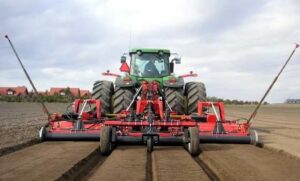 With a rotor that turns opposite the direction of travel, Forigo machines:
With a rotor that turns opposite the direction of travel, Forigo machines:
- Bury stones, clods, and debris
- Create fine, level seedbeds for transplanting
- Improve soil structure and drainage
They’re ideal for vegetable growers, specialty crops, and anyone who needs a well-formed, stable base for fall or spring planting.
Restock and Get Ahead
Even the smallest parts can bring an irrigation system to a halt if they fail. Fall prep is about making sure you have what you need before you need it.
Flip through our full product catalog to check off your list and make sure your system’s ready to handle whatever next season brings.
Need help finishing strong or planning your next move? Our team is here to help — and our full product catalog has what you need, from drip kits to reels and everything in between.
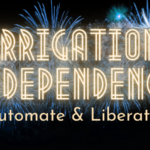
Irrigation Independence: Automate and Liberate
Summer is the season when smart irrigation isn’t just a luxury—it’s nonnegotiable. These next scorching weeks demand constant crop care, attentive watering schedules… and let’s face it, constant stress. But what if you could break free from all that?
This is the month of independence, so give yourself some too. Switch to automated watering and liberate yourself from the hold your outdated system has over you.
What can Automation do for me?
Key features include:
- Soil moisture sensors to monitor when water is truly needed
- Weather-based controls to prevent unnecessary watering
- Timers and schedulers so your system runs, even when you’re away
- Data and analytics that remove the guesswork from your decision’
Whether you’re running a nursery, managing a farm, or tending a greenhouse, automation helps you take action with confidence.
In short: less stress, more time and fewer 90-degree afternoons spent searching for leaks or adjusting timers. With automation, your irrigation works while you focus on the rest of your farm or finally take that Sunday off.
What Tools will work for my needs?
Here are just a few of the automation tools we trust and recommend:
- Valley Pivots and Control Panels – Ideal for large, precision-driven operations. Valley’s systems let you manage irrigation both at the control panel and remotely via smart devices. You’ll also get detailed performance data and historical records—helping you make smarter decisions season after season.
- Soil Moisture Indicators – These sensors give accurate readings of moisture levels at root depth, and many can be monitored remotely. Whether there’s unexpected rain or a sudden heatwave, you’ll know exactly when to water—and when to hold off.
- OCMIS GSM Module – Control your irrigation systems remotely with real-time updates on pump status, field mapping, start/stop functions, and detailed work hour reports. Perfect for those managing multiple systems or off-site operations.
- Flow Meters – A key part of water management. Track your system’s water usage in real time, detect leaks early, and identify inefficiencies that could be costing you money—or compromising your crop health.
- Netafim Drippers, Sprinklers, Misters, and Foggers – Designed for precision and adaptability, these components offer crop-specific irrigation solutions. Whether you’re growing produce, or nursery stock, Netafim delivers the right coverage with minimal waste.
- Adjustable Impact Sprinklers – Simple but effective. These customizable sprinklers offer wide coverage and are ideal for operations where versatility and reliability matter. Adjust spray distance and pattern to fit the needs of your specific layout.
Smart irrigation can reduce water use by up to 25%—which adds up fast in a hot, dry month like July.
Not sure what’s right for you? We’ll walk you through it.
Manual vs Automated Irrigation: What’s the Difference?
Still wondering whether it’s time to make the switch? Here’s how automation stacks up against manual watering:
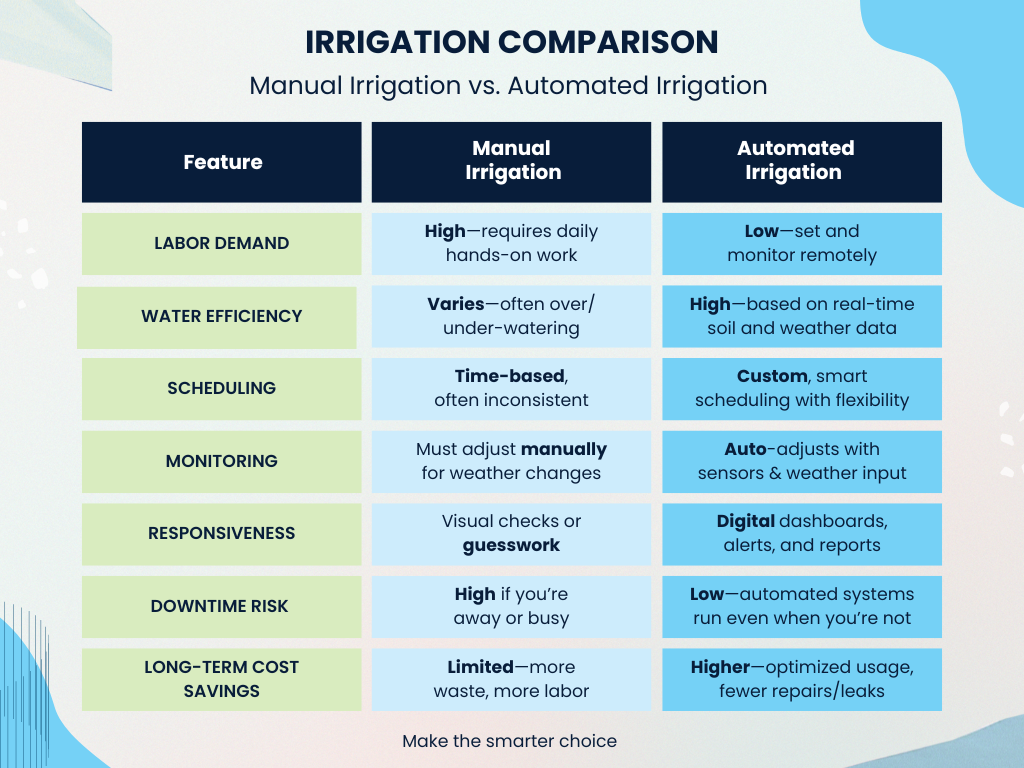
Finally Free
It’s time to take action. Get your independence back by giving us a call at 877.533.7878. One of our trusted team members will help you choose the automation tools that match your needs, goals, and budget.
Make July the month you reclaim your time and water smarter. Because your irrigation system should work for you—not the other way around

Irrigation Myths: 5 Things We Get Wrong (and How to Fix Them)
June is peak growing season and irrigation season. But misinformation still circulates across fields, farms, and greenhouses. At Lee Rain, we’ve seen firsthand how the wrong assumptions can lead to wasted water, lower yields, and system failures.
Here are five of the most common irrigation myths — and how to correct them with smarter practices and proven tools.
Myth 1: “It rains enough in June — I don’t need irrigation.”
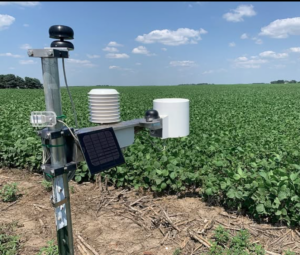
The Truth: Rainfall in June can be misleading. While it might look like enough on paper, uneven distribution and short dry spells can still stress your crops. Waiting for rain (or assuming it’s enough) can set you back during critical growth stages.
How to Fix It: Use a reliable irrigation schedule that supplements rainfall rather than relying on it. Monitor weather trends and soil moisture to ensure consistency across your fields.
Smart Tools to Help:
- AgSense by Valley: Monitor irrigation remotely by adjusting scheduling, water precision irrigation, and reduces over and under watering.
- Metos Soil Sensors: Accurately measure soil moisture levels taking the guessing game out of farming
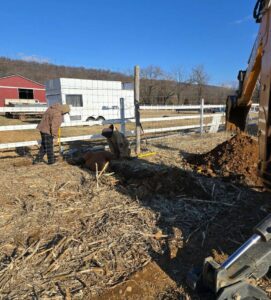
Myth 2: “I can skip maintenance until after the season.”
The Truth: Mid-season breakdowns are the most disruptive and they’re usually avoidable with regular checks and smart monitoring. Putting off maintenance can lead to lost crop potential and costly repairs.
How to Fix It: Build preventative maintenance into your regular schedule. Check for leaks, pressure drops, and uneven application before they become bigger issues.
Smart Tools to Help:
- Lee Rain Service & Parts Department: Our team is here to keep your systems running at peak performance. We’ll come out, inspect your equipment, and address potential issues before they turn into costly problems.
Myth 3: “Greenhouses and nurseries don’t need automation — a hose is good enough.”
The Truth: Manual watering is time-consuming and often inconsistent. For high-value or sensitive plants, over- and under-watering can quickly affect quality and profitability.
How to Fix It: Automate watering with precision systems designed for greenhouse and nursery environments. These systems improve consistency, reduce labor, and increase plant health.
Smart Tools to Help:
- Netafim MOD Drippers, NetBow™, Vibronet™, and MegaNet™ Sprinklers: Precision delivery for containers, benches, and beds.
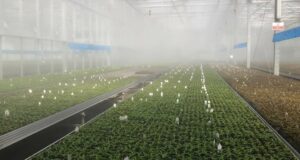
- Talgil: A wide range of automated control solutions that make irrigation easier, smarter, and more consistent — perfect for greenhouse and nursery operations
Myth 4: “Hose reels are just for sports fields and turf.”
The Truth: Portable irrigation isn’t limited to turf. Small farms, pastures, orchards, and hard-to-reach areas benefit greatly from flexible, mobile systems.
How to Fix It: Use portable irrigation systems to supplement permanent setups or reach areas that don’t justify fixed infrastructure.
Smart Tools to Help:
- Micro Rain MR Series: Sturdy, self-retracting hose reels designed for flexible
arrangement. - OCMIS Vario Rain: Durable, easy-to-service hose reel with built-in alert systems.
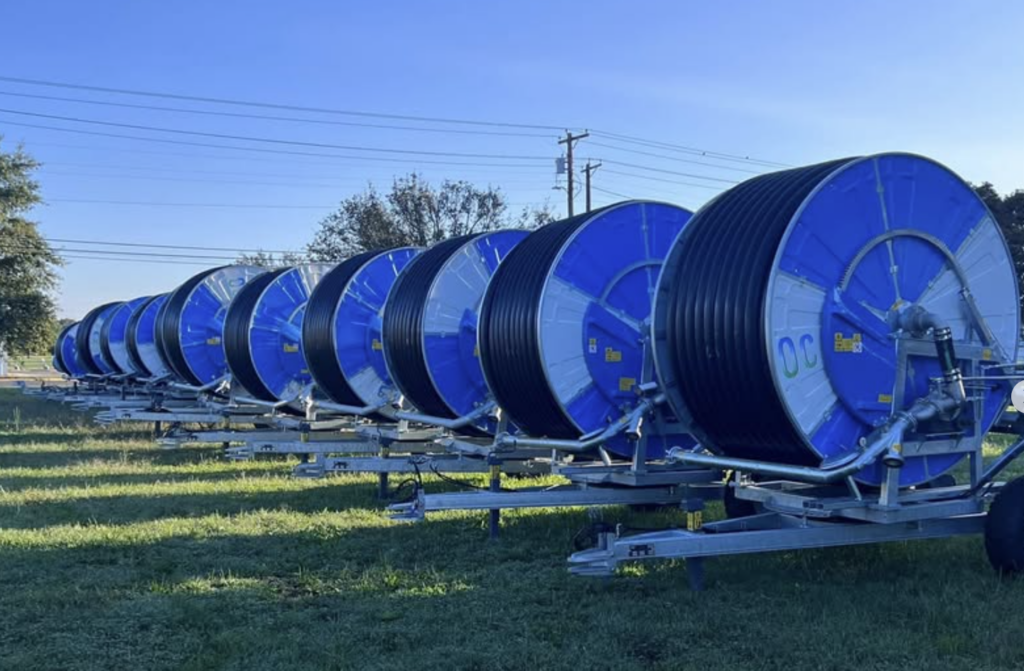
Myth 5: “Irrigation isn’t something I need to plan for — I’ll figure it out as I go.”
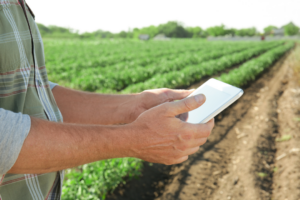 The Truth: Too often, irrigation is treated as a reactive task instead of a proactive strategy. But waiting until there’s a problem like crop stress, poor yields, or equipment breakdown, this usually means it’s already too late.
The Truth: Too often, irrigation is treated as a reactive task instead of a proactive strategy. But waiting until there’s a problem like crop stress, poor yields, or equipment breakdown, this usually means it’s already too late.
How to Fix It: Build irrigation into your seasonal planning from the start. That includes thinking about crop needs, water availability, infrastructure, and weather outlooks well before planting begins. Even a rough plan can help you respond faster, invest smarter, and reduce stress when the season heats up.
Irrigation isn’t just about equipment, it’s about mindset. The more intentional you are with planning, the more control you’ll have over the outcomes.
Final Takeaway
When it comes to irrigation, small misconceptions can lead to big consequences. By challenging these common myths and planning with intention, you can improve efficiency, protect your crops, and get more out of every drop. At Lee Rain, we’re here to support you with the knowledge, tools, and technology to help you grow smarter. This season and every season.
Have questions or want to learn more?
Call us at 877.533.7878 or email sales@leerain.com — we’re ready to help
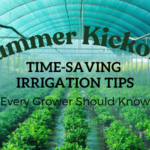
Summer Kickoff: Time-Saving Irrigation Tips Every Grower Should Know
Irrigation Tips to Save You Time (and Water) This Summer
Summer will be here before we know it, for most people that means longer days, less stress, and more time to relax. But for our hardworking farmers and nursery owners, the days are never quite long enough to get everything done.
We see you and we want to lighten the load.
That’s why we created a list of the most effective and reliable irrigation tips designed to save you time, water, and give you the smoothest operation- without adding more to your plate.
1. Automated Scheduling
Automated irrigation schedules take the guesswork (and daily adjustments) off your hands. Tailor each schedule to your crop types and field conditions, and let the system handle the rest.The pressure of the constant worry and checking is now out.
Need to adjust for a new season? Just update the schedule once.
Got a rainy day, upcoming drought, or maintenance work coming up? Most systems can auto-skip or reschedule watering with zero manual effort.
Best of all? The constant pressure of checking and rechecking is gone. You’ll spend less time worrying about your irrigation—and more time focusing on what really matters, whether that’s planning ahead, running your operation, or simply being present with the people you love.
2. Remote Monitoring
Your entire irrigation system—at your fingertips. All you have to do is check in from your smartphone, tablet, or computer no matter where you are.
Whether you’re catching up on paperwork, spending time with family, or taking a well-earned break, you can still stay in control.
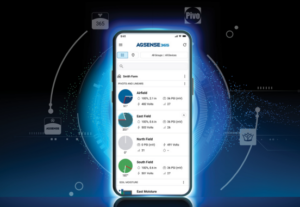 We recommend AgSense, Lee Rain’s go-to remote system created by Valley. It’s as simple as downloading the app. Plus, it’s compatible with any pivot system, so you’re not locked into a single setup.
We recommend AgSense, Lee Rain’s go-to remote system created by Valley. It’s as simple as downloading the app. Plus, it’s compatible with any pivot system, so you’re not locked into a single setup.
And when something unexpected comes up? You won’t have to drop everything, cancel plans, or drive out to the field. With remote access, you can respond instantly—without missing a moment.
3. Precision Irrigation
Drip lines, tape, and micro sprinklers deliver water right where your plants need it: the root zone. This kind of targeted irrigation reduces waste, re-working crops, and limits the need for constant
repositioning.
Our best-seller? Rain Tape.
This reliable drip tape delivers consistent, uniform irrigation—saving you time on monitoring and helping your bottom line by cutting down water use. We have two options to choose from:
Rain Tape EL (Emitter Line Drip Tape): Designed with flat emitters and an innovative 3D filtration system for superior performance.
Rain Tape RTX (Superior Performance Drip Tape): Engineered for enhanced durability and optimized performance under demanding conditions.
You can browse all of our precision irrigation tools in the Lee Rain Catalog.
4. Flow Meters & Leak Alerts
 Real-time flow monitoring helps you catch problems before they get serious. Flow meters get you instant alerts for leaks, clogs, or broken lines, so you can fix them fast and avoid costly downtime.
Real-time flow monitoring helps you catch problems before they get serious. Flow meters get you instant alerts for leaks, clogs, or broken lines, so you can fix them fast and avoid costly downtime.
Not sure which flow meter is right for you? We carry a range of flow meters—from simple mechanical options to advanced digital models that integrate with your irrigation controls. No matter the size of your farm or nursery, there’s a solution that fits.
5. Zoning & Customization
Divide your operation into logical zones—by crop type, maturity stage, sun exposure, etc.—and manage each one independently. Adjust time, flow rate, and delivery method per zone, and you’ll never need to reconfigure hardware between crops or seasons. Organized systems save time and give you better control over your irrigation.
6. Data & Reporting
Smart irrigation systems do more than water—they track performance. You’ll have detailed records of water usage, run times, and soil moisture at your fingertips. These logs help with planning, audits, and certifications, and give you data-driven insights to improve operations.
You can even use this data to; justify equipment upgrades, apply for rebates, reduce waste and improve sustainability. Ultimately saving you even more time in the long run.
Need help finding the right system for your farm or nursery?
We’re here to help. Reach out to the Lee Rain team for expert recommendations and tailored solutions.

A Farmers Guide into April
April Showers Bring Healthy Crops… And Some Other Challenges
As April rolls in, farmers across the country look forward to the much-needed rains that mark the season of growth. While rain is essential for healthy crops, it also brings its own set of challenges. Too much rain can lead to waterlogged soil, while not enough can leave your crops thirsty. That’s where Lee Rain comes in. We’re here to help you optimize your irrigation system to navigate the unpredictable nature of April weather.
With the right irrigation practices in place, you can make sure your crops get the water they need without over- or under-watering. In this article, we’ll walk you through four crucial steps to ensure you have a successful season ahead: staying informed about the weather forecast, checking soil moisture levels, fine-tuning your irrigation systems, and setting an up-to-date irrigation schedule.
1. Stay Informed: Track Weather Patterns for Smarter Irrigation
Every April is different, and weather patterns can shift dramatically. This makes staying up-to-date with the weather forecast essential. With reliable information on rainfall and temperature changes, you can adjust your irrigation schedule accordingly. Regularly checking your local forecast should become a daily habit. Even if you have a general idea of the weather for the month, conditions can change quickly—being informed will help you stay ahead of the curve.
This proactive approach prevents water waste, reduces the risk of over-watering, and ensures your crops receive the ideal amount of hydration. By optimizing your irrigation schedule, you can protect your crops and promote a healthier growing environment, leading to stronger, more productive harvests.
2. Monitor Soil Moisture for Accurate Watering
Soil moisture levels can fluctuate due to various factors, including rainfall, humidity, and temperature. Checking your soil moisture is the most effective way to ensure that your crops are receiving the right amount of water.
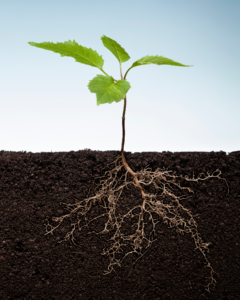 With advanced soil moisture technologies, you can get precise measurements of soil water tension. Lee Rain offers a wide range of tools that help you track soil moisture and water levels, ensuring your crops receive exactly what they need to thrive. Our solutions include sensors capable of measuring moisture at multiple depths, tailored to a variety of crops. With cutting-edge technologies, monitoring soil conditions can be as simple as checking your phone.
With advanced soil moisture technologies, you can get precise measurements of soil water tension. Lee Rain offers a wide range of tools that help you track soil moisture and water levels, ensuring your crops receive exactly what they need to thrive. Our solutions include sensors capable of measuring moisture at multiple depths, tailored to a variety of crops. With cutting-edge technologies, monitoring soil conditions can be as simple as checking your phone.
Not sure where to begin? Our experts at Lee Rain are here to help you find the right tools that align with your goals, crop needs, and budget. Regular soil moisture checks allow you to fine-tune your irrigation system, keeping your crops properly hydrated while minimizing water waste.
3. Optimize Irrigation System Performance
Ensuring your irrigation system is running efficiently is essential for providing your crops with the right amount of water. This involves checking for damage in your drip lines, ensuring proper placement, and verifying that your system is working as intended.
For those using drip irrigation, Lee Rain’s Rain Tape is a popular choice. This high-performance drip tape ensures smooth water flow with excellent clog resistance, delivering consistent irrigation directly to the roots. With Rain Tape, you can minimize water waste and ensure your crops are getting the optimal amount of hydration.
If you’re unsure which irrigation system will best suit your crops, a Lee Rain professional is ready to help. We’ll work with you to find the right solution tailored to your needs, ensuring your irrigation system performs at its best.
4. Set Your Irrigation Schedule
Once you’ve gathered the right information from weather forecasts and soil moisture tests, it’s time to adjust your irrigation schedule. This final step ties everything together, helping you ensure that your crops receive the right amount of water at the right time. With a customized irrigation schedule, you can make the most out of the April showers, keeping your crops healthy and ready for the growing season ahead.
Conclusion
April is a month of growth and new beginnings. By staying informed about weather patterns, monitoring soil moisture, and optimizing your irrigation systems, you can ensure your crops get the best care they need to thrive. At Lee Rain, we’re committed to providing you with the tools, resources, and expertise to help you manage irrigation effectively. Together, let’s make this growing season your best yet.

Advancing Agriculture: An Irrigation Guessing Game You Can’t Win
The problem with traditional irrigation management (i.e. manual or pre-set prescription), is that each irrigation timing event requires that you make two decisions, not just one. You must know not only when to stop irrigating (Decision #1), but also when to jump back in (Decision #2). And, assuming you get both calls right, you must repeat the process over and over, while factoring environmental conditions the plant is experiencing (i.e. heat, sun, wind, humidity and stage of growth, etc.).
After taking all this into account, it only takes one wrong irrigation decision to wipe out all of your prior successes, because even the slightest over or under-watering event negatively impacts yields every fifteen minutes. This is why Lee Rain believes that traditional irrigation management is a loosing proposition.
Recently, one of our patrons admitted that Lee Rain’s position on traditional irrigation made sense, but added: “I’m still tempted to stay in control and try to time my irrigation actions. When it hasn’t rained for a while, I believe that I need to irrigate regularly until the next rainfall. When that will happen, I don’t know. How much and when to irrigate is pure guesswork, but my irrigation is doing its job to minimize my losses and maximize my yield.”
Did you notice that this patron admits he doesn’t know, that he relies on guesswork? He’s certainly not alone. Gut instinct, intuition, overconfidence, and, yes, pride, have many folks just like him making irrigation bets based on their feelings alone.
Take a moment and think about it. If every farmer’s feelings were right all the time, every farmer would be rich.
Arbitrary irrigation timing (a.k.a. guesswork) also proves to be far more costly than the possibility of making the right call. That’s because frequent over and under-watering not only impacts yield, it also decreases nutrient use efficiencies, resulting in key nutrients being located beyond where the roots are able to extract them effectively.
These factors — negative yield impact and decreased nutrient use efficiency — collectively prove that arbitrary irrigation timing can be a costly and losing strategy.
Do you really want to play the guessing game? Do you want to win? It is time to invest in Plant-Triggered Irrigation. Lee Rain is confident that it is the best approach to higher profits.
Call us today to learn more.
Sincerely,
Lee Fiocchi, III
President

AgMS: Precision is Key in the Plant Empowerment Cycle
What is the basis behind the Plant Empowerment Cycle we employ to deliver Plant to Irrigation (P2i) process?
P2i is all about the interrelationship between translation, communication and implementation to make it all happen in the field. The Plant Empowerment Cycle, which illustrates how P2i works, involves three coordinated elements—Precise Plant Intelligence translating into Precise Evaluation, which is then communicated for Precise Action which is implemented to meet the Precise Crop Needs, instantly. But what are the principles behind this methodology and where do we start?
Precise Plant Intelligence
First, we accept the premise that plants are extremely aware of their environment, and are able to process and integrate information in sophisticated ways. Plants have the ability to adjust and adapt to changing circumstances relative to a particular environment. They accurately compute their circumstances, make sophisticated internal adjustments and take defined actions to mitigate and control diverse environmental situations.
In fact, a plant’s roots are the key. One might say their roots are their brains and are able to gather all sensory data every minute of every day, and integrate it to formulate an appropriate response. A root is a complex assemblage and very sensitive to water and oxygen supplies. Roots act like a distributed information processing network, similar to networks that organize information in computers. Recent studies indicate that this is actually the nerve center of the plant…underground intelligence.
Precise Evaluation
Second, we have built “translation” capabilities from the Intelligent Plant into Precise Evaluation. Water, and the subsequent oxygen ratios, is the most important factor which have both a positive and negative effect on the plant’s performance. When we precisely determine the plant’s needs related to the Most Active Root Zone (MARZ), we dramatically improve Plant and Soil Water Health in order to reduce Plant Stress on the crop.
Precise Action
Thirdly, our methodology includes the “communication” between the Precise Evaluation and the process necessary for Precise Action for instant implementation.
The fact of the matter is that the traditional irrigation practice of alternatively flooding and drying out is counter productive, as it upsets the sensitive balance the plants and the roots themselves live in. In the quest for avoiding such imbalances, Plant-Triggered Irrigation is designed to accurately apply water to meet the crop’s specific needs in a precise, accurate and timely manner. More importantly, Plant-Triggered Irrigation is designed to remotely administer real-time optimal water applications for achieving crop quality and higher yields objectives without human intervention.
Without human intervention, Plant-Triggered Irrigation supports real-time communication between the growing plant (P) and action taking irrigation machines/devices (I) in order to meet precise crop demands for water without the side effects of negative plant stress. Plant-Triggered Irrigation performs irrigation tasks that normally require human intervention.
Real-Time Response
Once the Plant Empowerment Cycle is completed and the plant responds to a precise irrigation event, the system is designed to do it all aver again in real-time, 24/7. Simply stated, without Plant to Irrigation (P2i) via the Plant Empowerment Cycle, the precise and timely application of water to meet precise plant needs that reduces crop stress for improving yields would be impossible.

Vision: Are You an Irrigation Surfer or Sailor?
Just for fun, since plant health and performance is directly impacted by the environmental conditions (both above and below the soil surface), tell me the amount of rainfall that occurred on June 6 of last year. Wait, I’ll make it easier – tell me the total rainfall of any date in June last year?
Stumped? Well, so am I. Who could possibly remember that?
By that notion, you’ll soon forget today’s rainfall total too. And that’s the point: If you are a grower who implements Plant Triggered Irrigation —as we counsel our clients to use— there is no need to be concerned with what rainfall occurred or for that matter if the temperature, humidity, wind speed or sunlight intensity is influencing plant health on any particular day, hour or minute because the plant itself tells the irrigation system what it wants or needs every fifteen minutes.
Without Plant Triggered Irrigation, when weather instability occurs, some folks call us expressing worry and a few showed outright fears about their crop’s capability to produce high yield and quality. Because traditional irrigation managers must manually intervene, it’s the outguessing and subsequent irrigation action that promotes anxiety to try, and usually fail, to bring plant health back into balance.
I can’t help but notice that some clients never thought to complain when timely rainfall, perfect temperatures and full sunlight are all in alignment for the perfect crop. They object only to downside weather volatility, which negatively impacts yield, disease or quality—failing to realize that they can’t have one without the other.
Consider Monday, June 5, 2014. It rained 1½ inches and temperature fluctuated from 72 degrees to 90 degrees—its greatest temperature swing since May. The next day was much cooler and cloudier, plus it rained ½ inch. But on Wednesday, it was sunny, 85 degrees and the relative humidity rose above 85% and windy. Thursday the temperature topped out at 90 degrees, rained ½ inch, the wind was calm and it was sunny in the morning and cloudy in the afternoon. On Friday it was very sunny from dusk until dawn, a mild wind and the temperature peaked at 90 degrees by 3:30 in the afternoon.
What a wild week of weather gyrations! And we’ve seen additional bursts of weather unpredictability—both too much and too little—many times since. Every week, every day, every hour and every fifteen minutes is different and good managers can’t keep up if production optimization is their goal. With manual or prescriptions irrigation techniques, it’s impossible to start and stop irrigating in a timely fashion before plant stress occurs.
So if you find weather volatility discomforting as it relates to your irrigation action plans, perhaps my analogy of surfers and sailors might help.
Surfers love the thrill of riding the ocean’s waves. But they often wipe out.
Sailors, by contrast, know that waves don’t effect the times. The ocean ebbs and flows on a regular schedule; tides are predictable, measurable and manageable.
Which one are you? Call us today if you think Plant Triggered Irrigation is right for you.
Sincerely,
Lee Fiocchi III
President

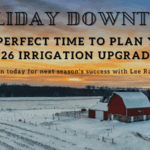
 Reflect Before You Restart
Reflect Before You Restart
